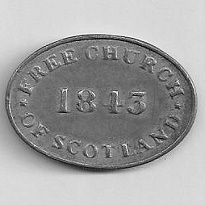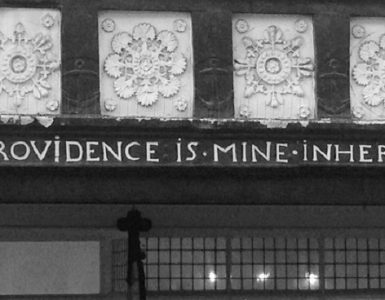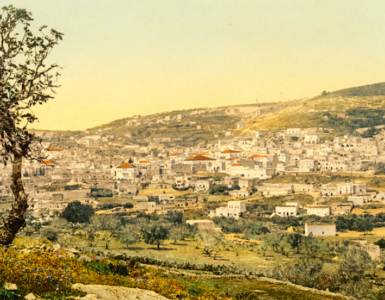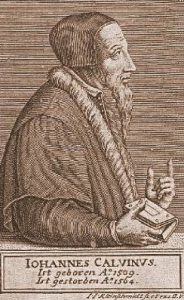 Communion tokens became prominent in Reformed churches at least partially due to John Calvin advocating their use. In a letter to Guillaume Farel written from Strasbourg, March 29, 1540, Calvin commented regarding the Lord’s Supper that “On Easter-day, when I gave out the invitation that we were to celebrate the Supper on next Lord’s day, I announced, at the same time, that no one would be admitted to the table of the Lord by me, who had not beforehand presented himself for examination.” Here is seen early in Calvin’s reforming work his concern that those coming to the Supper would partake of the elements in a worthy manner as determined by examination. Though the question was not asked in this particular correspondence and may not have become apparent until later, one has to wonder how the church member coming to the Supper was known to be worthy? In the current context of churches that fence the table, the worthiness of the communicant is the responsibility of the partaker to determine unless the person has been separated from the Lord’s table by the elders for sin.
Communion tokens became prominent in Reformed churches at least partially due to John Calvin advocating their use. In a letter to Guillaume Farel written from Strasbourg, March 29, 1540, Calvin commented regarding the Lord’s Supper that “On Easter-day, when I gave out the invitation that we were to celebrate the Supper on next Lord’s day, I announced, at the same time, that no one would be admitted to the table of the Lord by me, who had not beforehand presented himself for examination.” Here is seen early in Calvin’s reforming work his concern that those coming to the Supper would partake of the elements in a worthy manner as determined by examination. Though the question was not asked in this particular correspondence and may not have become apparent until later, one has to wonder how the church member coming to the Supper was known to be worthy? In the current context of churches that fence the table, the worthiness of the communicant is the responsibility of the partaker to determine unless the person has been separated from the Lord’s table by the elders for sin.
Mention of the use of tokens, the French méreaux, is found in the records of the Council of Geneva. The promoters of their use were John Calvin and Peter Viret. These reformers appeared before the Small Council, January 30, 1560, and expressed their desire that the méreaux be used to prohibit desecration of the Lord’s Supper by unworthy communicants. Those who desired to partake of the elements would have to possess a token for presentation to the minister to prove their worthiness in the spirit of 1 Corinthians 11:27. However, Calvin and Viret’s proposal was not adopted, but Calvin went on in an undated letter, circa 1561, to again appeal for the use of the méreaux. The Council of Geneva, however, would not allow this practice. Even though the use of tokens was not adopted in Geneva, by 1560 the Huguenots of France and the Presbyterians in Scotland were using tokens.
As the years passed, the communion token became a part of Reformed and Presbyterian Lord’s Supper practice. Those who wanted to take the Lord’s Supper, which was often practiced during an annual communion season, would be interviewed by the session, elders, and if found to be worthy they would be given a token. So, when the communicant went to be served the elements in the service the token was given to the administrating minister or elder. They were commonly used in Scotland and when Scots and Scots-Irish Presbyterians emigrated to America they took their use of communion tokens with them. The tokens pictured here are all from Scotland. Colonial American tokens are rare because sometimes they were made of less durable materials such as paper, ceramic, or wood. The use of tokens in the United States came to an end for many Presbyterians by the end of the nineteenth century but some continued the practice until well into the twentieth.
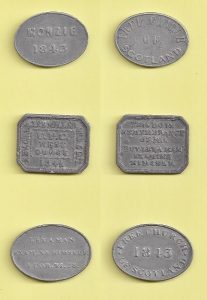 Both sides of each token are shown side by side. The size of each of the three tokens is such that it would fit within a rectangle 1 inch high by 1 1/4 inches wide.
Both sides of each token are shown side by side. The size of each of the three tokens is such that it would fit within a rectangle 1 inch high by 1 1/4 inches wide.
Top: White Metal, left, “Monzie 1843,” right, “Free Church of Scotland.”
Middle: Pewter, left, “Rev. Charles Miller Ord. 5 Oct. 1844” [perimeter], “UPC West Dunse” [center], right, “This do in remembrance of me. But let a man examine himself.”
Bottom: White Metal, left, “Let a man examine himself, 1 Cor. XI.28,” right, “Free Church of Scotland 1843.”
The picture was taken by the author. Note that “white metal” is a generic term for any of a variety of alloys containing high percentages of lead or tin; “pewter” is an alloy of tin and lead, or of tin, lead, and brass.
BY BARRY WAUGH
Sources—Selected Works of John Calvin, Tracts and Letters, edited by Henry Beveridge and Jules Bonnet, vol. 7, Letters, Part 4, 1559-1564, Grand Rapids: Baker Book House, 1983. William Monter, Calvin’s Geneva, New York: John Wiley and Sons, 1967. “Mélanges: Le Méreau dans Les Eglises Réformées de France,” Bulletin de la Société de L’Histoire du Protestantisme Français 37 (1888). Communion Tokens, Their Origin, History, and Use, by Mary McWhorter Tenney and published by Zondervan, 1936. They were not consulted for this article, but there are also catalogs of communion tokens much like rare coin catalogs, for example, Communion Tokens of the United States of America, by Autence A. Bason, which was apparently self published.


